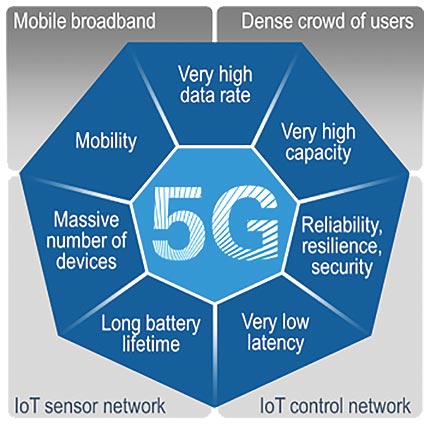
The evolution of Cellular Systems
As Cellular Systems have evolved, each generation has bettered the performance of the earlier generations.
- First generation 1G: These phones were analogue and were the first mobile or cellular phones to be used. Although revolutionary in their time they offered very low levels of spectrum efficiency and security.
- Second generation 2G: These were based around digital technology and offered much better spectrum efficiency, security and new features such as text messages and low data rate communications.
- Third generation 3G: The aim of this technology was to provide high speed data. The original technology was enhanced to allow data up to 14 Mbps and more.
- Fourth generation 4G: This is an all-IP based technology capable of providing data rates up to 1 Gbps. Presently they offer internet speeds of up to 150Mbps in areas that offer double LTE and LTE-A (or 4G+ on EE). This is likely to increase to 300Mbps
- The future – Fifth generation 5G: This will provide significant gains over 3G/4G. 5G technology will ensure far better levels of connectivity and coverage. It will provide a true ‘wireless world wide web’ (wwww ). In order to achieve this, new methods of connecting will be required. 5G technology will need to address the main drawbacks of previous generations viz lack of coverage, dropped calls and low performance at the edge of the cell.
5G
5G technology will use Open Transport Protocol (OTP). OTP is supported by Transport and Session layer. The application layer will be for quality of service management over various types of networks. 5G will bring forward a real wireless world – wireless world wide web (wwww).
5G will allow for faster service, less latency, and will enable more devices to be connected across the globe. This high speed network will support the massive growth of IoT(Internet of Things), and enable devices to communicate with each other seamlessly through the convergence of mobile communications and computing.
5G will run on a new “high-spectrum band”, which uses higher frequency signals than 4G. The new band will be much less congested than at present. This will be vital for use with the ‘Internet of Things’. However, as the signals will not be able to travel far, there will be need for more access points, positioned closer together.

Target Features of 5G
- 1 Gb/s or more data rates to support ultra-high definition video and virtual reality applications
- Less than one millisecond latency to support real time communications
- Seamless delivery of services across licensed and unlicensed spectrum
- Standard – IP broadband LAN/W AN/PAN & WWWW
- Always-on user experiences
- Support for billions of users, or M2M systems
- Energy consumption expected to be considerably reduced to improve upon M2M device battery life. Nearly 90% reduction in network energy usage.
- Real time performance – Fast response, low jitter, latency & delay
- Supports IoT & M2M – 100 times more connected devices.
5G applications
- People and Devices will stay ‘connected’ anywhere anytime. This will make the world a real Wi Fi zone.
- Mobile IP address will be assigned as per the connected network and geographical position.
- Parallel multiple services, such as knowing the weather and location, while talking on the phone.
- Control of PCs using handsets.
- Remote education will become easier – a student sitting in any part of world can attend the class.
- Remote diagnostics – a doctor can advise a patient located in a remote part of the world.
- Governmental organization and investigating offers can monitor any part of the world – potential reduction in crime rate.
- Potential to promptly detect and alert the concerned authorities and individuals in the event of natural disasters like tsunami, earthquake etc.
- Faster and more robust networks would imply better quality images for both surveillance and analytics.
Implications for security
5G networks will bring a whole new array of opportunities to the security industry. The faster and more robust network would mean more connected and autonomous devices and systems, as well as better quality images and faster streaming. Video surveillance and I.o.T .are tied together, as products such as cameras and recorders have predominantly moved to IP and are connected together on the Internet. Gathering information through analytics will become more main stream, as the data produced will provide more information and more knowledge. This in turn will help organizations evolve better business strategy plans.
Future applications
With fast wireless connection for cloud computing, data services, and other connected devices, 5G can facilitate a range of advanced capabilities, user experiences and devices. A few examples are listed below:
- self-driving cars with built-in intelligent traffic routing
- improved city infrastructures
- intelligent machines and sensors
- augmented reality and more.

Summary
- 5G network promises faster service, less latency, and enables more devices to be connected across the globe.
- 5G will support the massive growth of the ‘Internet of Things’ and enable devices to communicate with each other seamlessly through the convergence of mobile communications and computing.
- 5G would be a technology that is “just there”, like any utility, be it electricity or plumbing.
- It will enable device manufacturers to realise the Internet of Things as it will always be on.
- Security players are likely to face certain challenges such as storage issues to manage data and hardware compatibility.
In Part II we will discuss the implications of 5G for Security, Surveillance and Smart Cities.

